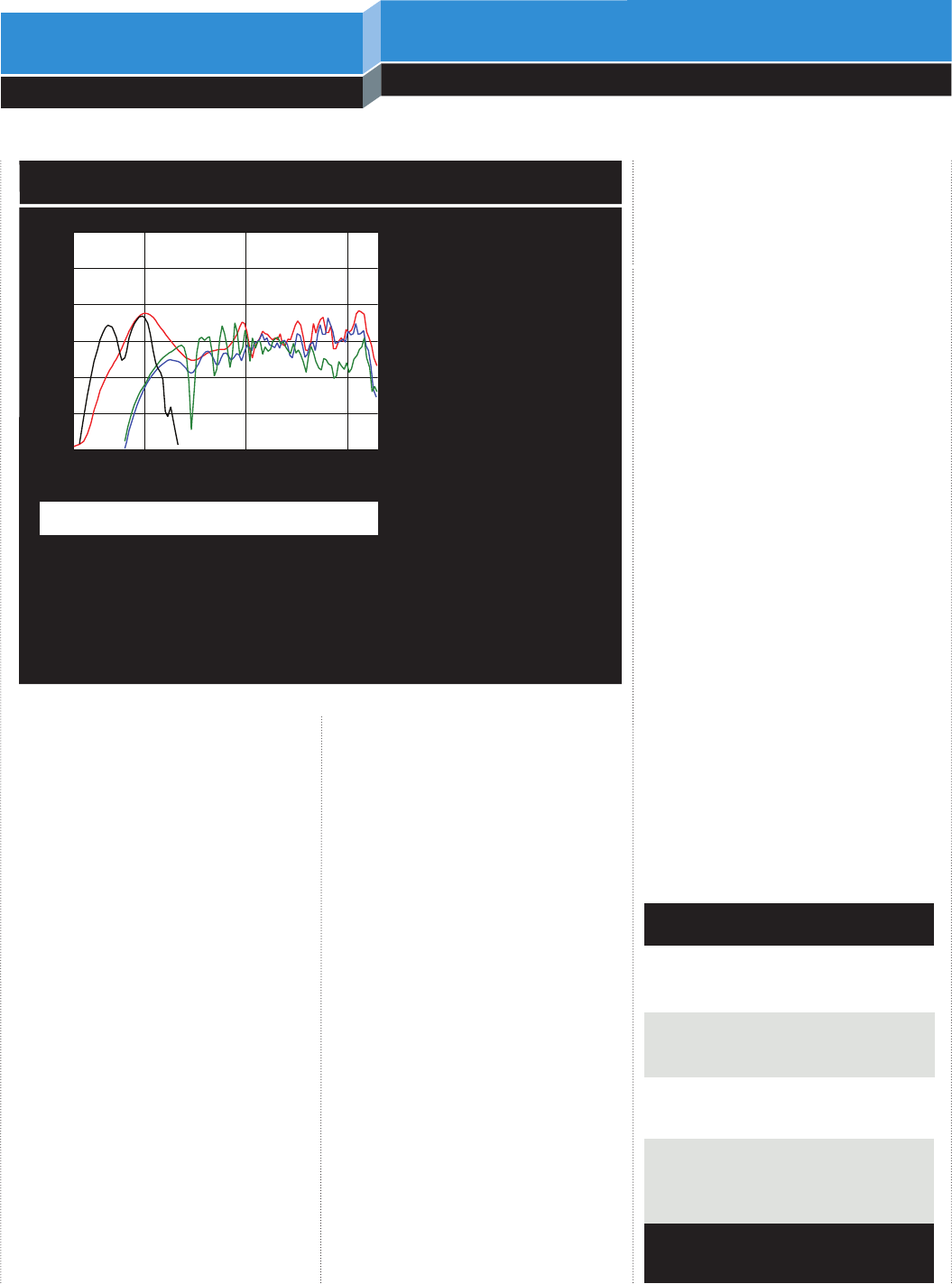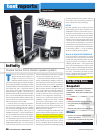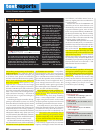
GRAYSCALE
Before Calibration
test reports
outstanding transparency in the mid to
high frequencies. This yields the kind of
treble that doesn’t sound at all bright, yet
is all there: clear, quick, and extended,
and not in the least bit forward or sparkly.
Voices were unfailingly even, balanced,
and, well, neutral. Most speakers, even
high-end ones, “romance” the vocal range
with a subtle extra helping of warmth in
the 100- to 200-Hz octave, but not the Clas-
sias. This occasionally made them sound a
little “cool,” but it also encouraged close,
high-resolution listening — the kind of
sound you hear in a good recording-stu-
dio control room.
Something analogous seemed to be hap-
pening in the bottom octaves, too, where
the C336s delivered solid output to 40 Hz
or so, but with less of that penultimate-
octave response hump that enhances the
impression of bass on so many speakers.
The overall effect on material like Richard
Thompson’s “Hide It Away” (from you? me?
us?) was intensely but effortlessly intimate,
without the tinge of low-end bloat that this
midbass-heavy track can often reveal.
On the multichannel front, Infinity’s lay-
out demonstrated some welcome abilities.
The CC225 center speaker’s tonal match
to the C336s was excellent — not perfect,
but impressively close for a two-way hori-
zontal design. For instance, comparisons
of TV and FM announcers between sin-
gle- and dual-speaker mono revealed only
modest shifts of vocal weight and “hoo,”
even among baritone male voices. The
tonal stability wasn’t quite as good when
the center speaker was listened to off-axis,
but it was still well above average.
The C255ES surround speakers per-
formed admirably in both dipole and
bipole settings. They delivered plenty of
clean level in my fairly large listening
room — even in dipole mode — and made
a tight enough tonal match to the C336s
in bipole position to please even the most
demanding multichannel-music maven.
Gone Baby Gone is one of those 2-hour
films that demand full-bore, all-channels
excellence for only about 90 seconds —
but those 90 seconds are absolutely crit-
ical. The brief action interludes are all
the more shocking and powerful for the
dynamic range they carry, and the Infin-
ity suite delivered this with heart-stop-
ping conviction. For the rest of the film,
I was entirely engrossed by its seamless
tapestry of dialogue, street-scene and inte-
rior ambience, and subtle musical score. Is
there any higher praise for a soundtrack or
a sound system?
Last but not least is the PSW310W sub,
which has an active 10-inch driver com-
plemented by two 10-inch cones that serve
as passive radiators (ports, more or less).
It also incorporates Infinity’s RABOS sin-
gle-band parametric EQ, which can help
to reduce a primary room resonance. (A
kit that includes a test-tone CD and setup
graphing tools is a $60 option.)
The PSW310W didn’t get much of a work-
out from Gone Baby Gone, so I turned to a
handful of my favorite subwoofer torture
tests from classics like Godzilla and The
War of the Worlds. The verdict: impres-
sive. The woof goes admirably low with
substantial power, and it sounds clean and
tight all the way down. The ’zilla footfalls
lacked some of the wall-bending 20 Hz of
my everyday sub (a 12-incher about twice
the Infinity’s price), but they had plenty of
slam just the same. It’s a solid sub — and
did I mention that it’s wireless?
BOTTOM LINE
With the Classia speakers, Infinity has
managed to combine high sonic capabili-
ties with striking appearance and respect-
able value. Visually, this system might not
satisfy every taste (for the record, I dug
them), but for those to whom its uncon-
ventional looks speak, it should appeal
strongly. Better yet, they’ll also enjoy
sound that’s just as striking. S&V
INFINITYSYSTEMS.COM ::
516-674-4463
Key Features
GRAYSCALE
Test Bench
the center speaker’s bass-to-
treble balance rises at slightly
less than 1 dB per octave, with
reasonably uniform directivity
up to ±30º. Both speakers’
mid/tweeter arrays emitted
fairly acute noises when given
our ramped test signals at fre-
quencies below their specified
bass limit. The C255ES sur-
round speaker displays the nar-
row bandwidth and irregulari-
ties typical of bidirectional
speakers. The PSW310W sub-
woofer has response up to
400 Hz when its crossover is
bypassed, making it useful for
pairing with small satellites.
The sub has relatively limited
dynamic capability and low-fre-
quency extension, but its
sound-pressure abilities are
uniformly distributed over its
bandwidth. — Tom Nousaine
Surround ■■ 135 Hz to 16.1 kHz ±6.7 dB
Subwoofer ■■32 Hz to 130 Hz ±3.2 dB
L/R ■■51 Hz to 19.1 kHz ±3.7 dB
Center ■■156 Hz to 17 kHz ±3.9 dB
C336 ($1,798/pair)
:: 1-in tweeter; 4-in midrange; (3) 6
1
⁄
2
-in
woofers; 48
3
⁄
4
in high; 56 lb
CC225 ($499)
:: 1-in tweeter; (2) 5
1
⁄
4
-in woofers; 31
3
⁄
4
in wide; 16 lb
C255ES ($998/pair)
:: (2) 1-in tweeters; (2) 5
1
⁄
4
-in woofers;
11
3
⁄
4
in high; 9 lb
PSW310W ($799)
:: 10-in woofer; (2) 10-in passive radiators;
400-watt amplifier; 17
1
⁄
2
x 15 x 14 in;
50 lb
68 SEPTEMBER 2008 SOUND & VISION soundandvisionmag.com
Infinity Classia speaker system
The C336 tower’s measurements indicate a wide
floor bounce centered at 200 Hz, followed by nar-
row band irregularities beginning at 800 Hz. The
CC225 center displays a similar character at
higher frequencies, along with low-frequency
response that falls quickly below 400 Hz. Overall,
20 100 1k 10k 20k
hertz (Hz)
15
10
5
0
–5
–10
–15
decibels (dB)




